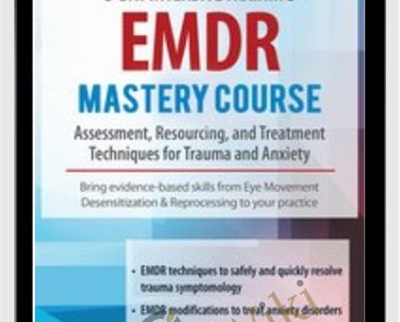EMDR Mastery Course: Assessment, Resourcing and Treatment Techniques for Trauma and Anxiety – Jennifer Sweeton
Original price was: $599.99.$183.00Current price is: $183.00.
EMDR Mastery Course: Assessment, Resourcing and Treatment Techniques for Trauma and Anxiety – Jennifer Sweeton Download. EMDR has helped thousands of clien…
Salepage link: At HERE. Archive:
EMDR has helped thousands of clients reclaim their lives; quickly and consistently helping them find relief from the trauma and anxiety that plague them.
But without guidance, and hands-on practice, you’re unable to bring this groundbreaking evidence-based treatment to your clients who so desperately need it.
This EMDR Mastery Course recording is your chance to get powerful and proven skills and techniques from EMDR so you can move your clients from surviving to thriving!
You’ll be given a roadmap to help clients manage disturbing feelings, safely process their traumatic memories, reduce fears and anxiety, and help them to develop the resources they need to achieve and maintain recovery.
This intensive training also includes hands-on opportunities for you to practice, reinforcing what you’ve learned and allowing you to gain confidence in using your new skills.
Take your treatment to the next level with EMDR skills and techniques to quickly and safely bring relief from trauma and anxiety to your clients!
- Determine the role of the autonomic nervous system in trauma and anxiety symptomology.
- Articulate the clinical implications of the freeze response in trauma treatment.
- Characterize the potential neurobiological mechanisms of change in the empirically validated? EMDR approach.
- Specify how EMDR techniques can build dual awareness in clients to treat the avoidance that makes trauma and anxiety treatment challenging.
- Employ the 8 Phases of the EMDR protocol.
- Determine which clients you should use EMDR with.
- Appraise the relevance of Polyvagal Theory and early trauma in EMDR work.
- Communicate the central principle of the Adaptive Information Processing Theory and establish how it informs the EMDR approach.
- Analyze resourcing strategies from EMDR that clinicians can use to help facilitate the processing of trauma.
- Specify the steps clinicians must take to emphasize safety during EMDR sessions.
- Determine how EMDR can be modified to treat anxiety disorders.
- Differentiate between EMDR strategies recommended for trauma and EMDR strategies recommended for anxiety.
- Characterize how EMDR techniques can be used to reinforce and activate positive neural networks.
- Defend how EMDR can be modified to work with complex/developmental trauma to directly treat traumatic memories.
- Evaluate strategies that can help foster the critical connection between client and therapist in? EMDR therapy.
- Formulate the order of operations for attachment-based EMDR treatment to resolve relational trauma.
- Articulate how EMDR can be modified to work with Borderline Personality Disorder, Dissociative Identity Disorder, and Generalized Anxiety Disorder.
- Differentiate between EMDR and Brainspotting by communicating the strengths and limitations of each.
The Neuroscience of Trauma and Anxiety
- Introduction to the autonomic system (ANS)
- Fight, flight, freeze, fawn survival responses
- Polyvagal Theory, and types of freeze responses
- Key brain areas involved in trauma and anxiety
- Clinical implications of the freeze response
Mechanisms of Change: How EMDR and Other Treatment Approaches Work
- The neuroscience of exposure therapy and cognitive therapy
- The neuroscience of relaxation exercises
- EMDR and other “transformative therapies”
- Mechanisms of change
- Why EMDR works so well from a brain perspective
Assessment: Connect Symptoms and Presentations to a Diagnosis
- Nervous system switched on/off – PTSD and Depression
- Underactivations and weakened connections
- Trauma memories and intrusive thoughts
- Phobias, anxiety and insula hyperactivation
- Emotional hijackings and implicit memory: Basal ganglia and amygdala
- Why treating avoidance is critical in anxiety and trauma
- DSM-5® symptoms in a nutshell
- Connect Your Client to a Diagnosis
- Simple vs. complex trauma
- Intergenerational trauma
- Symptom clusters and physical
- manifestations
- CAPS-5 and PCL-5
- Primary Care PTSD Screen
- Dual diagnosis
EMDR as Applied Neuroplasticity
- How EMDR builds dual awareness to treat avoidance
- What you are thinking about is the network you’re in
- You need to activate a network to change it
- Neurons that fire together, wire together (Hebb’s Rule)
- EMDR as neuroentrainment
Practical EMDR Techniques and Protocols to Move Clients from Surviving to Thriving
EMDR Assessment, Resourcing, Eye Movements and More: How to Work with the Original 8-Phase Model
- Client history and treatment planning
- How to resource: Create a safe space
- Assessment: Choose a target, SUDS, connect with the image/emotions/thought
- Desensitization: tactile vs. auditory vs. eye movement
- How to use Touchpoints, Theratapper, CDs
- Positive Cognition Installation: Likert scale 1-7
- Body Scan: Locating tension and distress in the body
- Closure: Closing the neural network and the 6-hour window
- Re-evaluation
When to Use EMDR in Trauma and Anxiety Treatment
- Demonstrations and experiential exercises
- Single event trauma
- Anxiety disorders involving imaginal exposure
- Demonstration of original 8-Phase Model
- ***Experiential exercises with groups of three: client, therapist, observer
- Preparation and assessment
- Desensitization
- Positive cognition and body scan
EMDR for Direct Treatment of Traumatic Memories
- Modifications for complex/developmental trauma
- Do not use standard protocol – Rationale for modifications
- Resourcing strategies:
- Container
- Comfortable place
- Nurturing figure
- Protective figure
- Circle of support
- Techniques to reinforce and activate positive neural networks
- Relevance of Polyvagal Theory, early trauma, and EMDR
- Sensory motor modifications and somatic approaches
- How to build Dual Awareness
- Adaptive Information Processing Theory
- EMDR techniques to bring traumatic memories into the prefrontal cortex
Attachment-Based EMDR for Resolving Relational Trauma
- Strategies to foster the critical connection between client and therapist
- How to emphasize safety during sessions
- Guidance on order of operations:
- Resourcing with multisensory guided imagery
- Activate trauma network
- Desensitization round
- Ask, “What is coming up?”
- How to install positive cognition
- Identify and resolve remaining tension or distress in the body
- Debrief clients to ensure embodiment
EMDR Modifications for Anxiety Disorders
- Modifications for phobias and generalized anxiety
- Resourcing strategies for self-efficacy and control
- Imaginal exposure and exposure through pictures and videos
- Techniques to reinforce and activate positive neural networks
- How to build Dual Awareness and reduce avoidance
EMDR Modifications for Other Disorders
- Borderline Personality Disorder
- Dissociative Identity Disorder
- OCD
- Generalized Anxiety Disorder
EMDR vs Brainspotting vs EFT vs Neuromodulation
- When to use each
- Strengths and limitations of each
- Overview of how to conduct a Brainspotting session
- Overview of how to conduct an EFT session
- Integrating neuromodulation and EMDR for faster, more effective treatment
Research Limitations and Potential Risks
Here's an overview of the prominent keywords and a list of famous authors:
Business and Sales: Explore business strategies, sales skills, entrepreneurship, and brand-building from authors like Joe Wicks, Jillian Michaels, and Tony Horton.
Sports and Fitness: Enhance athleticism, improve health and fitness with guidance from experts like Shaun T, Kayla Itsines, and Yoga with Adriene.
Personal Development: Develop communication skills, time management, creative thinking, and enhance self-awareness from authors like Gretchen Rubin, Simon Sinek, and Marie Kondo.
Technology and Coding: Learn about artificial intelligence, data analytics, programming, and blockchain technology from thought leaders like Neil deGrasse Tyson, Amy Cuddy, and Malcolm Gladwell.
Lifestyle and Wellness: Discover courses on holistic health, yoga, and healthy living from authors like Elizabeth Gilbert, Bill Nye, and Tracy Anderson.
Art and Creativity: Explore the world of art, creativity, and painting with guidance from renowned artists like Bob Ross and others.
All the courses on WSOlib are led by top authors and experts in their respective fields. Rest assured that the knowledge and skills you acquire are reliable and highly applicable.
Specification: EMDR Mastery Course: Assessment, Resourcing and Treatment Techniques for Trauma and Anxiety – Jennifer Sweeton
|
User Reviews
Only logged in customers who have purchased this product may leave a review.

Original price was: $599.99.$183.00Current price is: $183.00.












There are no reviews yet.